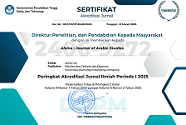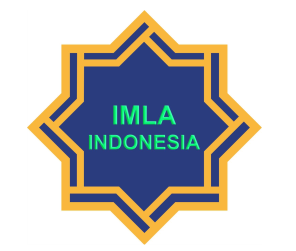Pengembangan Aplikasi Edukasi Kuis Bahasa Arab sebagai Alternatif Media Belajar Siswa Kelas I Madrasah Ibtidaiyah
DOI:
https://doi.org/10.21580/alsina.3.2.8432Keywords:
ADDIE, Arabic learning, Arabic language, Educational applicationsAbstract
Vocabulary is one of the most critical linguistic components that Arabic as a foreign language learners must master. Previous studies discovered that it was accurate that first-grade students struggled to recognize and master Arabic vocabularies since the learning process mainly consisted of lectures and homework. Students need external help or stimulation to increase their comprehension of Arabic. Educational games may encourage first-grade students since they like to play and explore electronic devices such as androids, laptops, and so on. This study aims to develop an educational application that contains acceptable Arabic vocabulary content for first grade (elementary school) students. The research employed the ADDIE (Analysis-Design-Development-Implementation-Evaluation) paradigm of research and development. This study involves developing an educational application called "Arabic Quiz", which utilizes the Articulate Storyline 360 software. According to feasibility tests conducted by a media expert, a material expert, and prospective consumers, this application has an "excellent" category. The program is suited for use as an alternative learning media for first-grade students.Downloads
References
Alobaydi, E K, R Y Alkhayat, M R M Arshad, and E R Ahmed. “Context-Aware Ubiquitous Arabic Vocabularies Learning System (U-Arabic): A Framework Design and Implementation.” In 2017 7th IEEE International Conference on Control System, Computing and Engineering (ICCSCE), 23–28, 2017. https://doi.org/10.1109/ICCSCE.2017.8284373.
Azizah, Hanifah Nur. “Peningkatan Penguasaan Kosakata Bahasa Arab Melalui Penggunaan Media Word Wall.” ALSUNIYAT: Jurnal Penelitian Bahasa, Sastra, Dan Budaya Arab 1, no. 1 (2018): 1–16. https://doi.org/10.17509/alsuniyat.v1i1.24212.
Batubara, Hamdan Husein. Media Pembelajaran MI/SD. Buku Ajar. Semarang: Fatawa Publishing, 2020.
Blumberg, Fran C, and Shalom M Fisch. “Introduction: Digital Games as a Context for Cognitive Development, Learning, and Developmental Research.” New Directions for Child and Adolescent Development 2013, no. 139 (2013): 1–9. https://doi.org/10.1002/cad.20026.
Derakhshan, Ali, and Elham Davoodi Khatir. “The Effects of Using Games on English Vocabulary Learning.” Journal of Applied Linguistics and Language Research 2, no. 3 (2015): 39–47. http://www.jallr.com/index.php/JALLR/article/view/40.
Djamarah, Syaiful Bahri, and Aswan Zain. Strategi Belajar Mengajar. Jakarta: Rineka Cipta, 2006.
Dwi Rahmawati, Anita. “Pengembangan Video Pembelajaran Bencana Erupsi Gunungapi Di SMP Negeri 2 Nogosari Kabupaten Boyolali.” Universitas Muhammadiyah Surakarta, 2020.
Fakhruddin, Abdul Aziz, Mochammad Firdaus, and Lailatul Mauludiyah. “Wordwall Application as a Media to Improve Arabic Vocabulary Mastery of Junior High School Students.” Arabiyatuna: Jurnal Bahasa Arab 5, no. 2 (2021): 217–34. https://doi.org/10.29240/JBA.V5I2.2773.
Hakim, Muhammad Luqman, Akhyar, and Asrowi. “Pemanfaatan Media Pembelajaran Game Interaktif Dalam Pembelajaran Kosakata Bahasa Arab.” Arabi: Journal of Arabic Studies 2, no. 2 (December 2017): 156–62. https://doi.org/10.24865/AJAS.V2I2.56.
Huang, Yong-Ming, and Yueh-Min Huang. “A Scaffolding Strategy to Develop Handheld Sensor-Based Vocabulary Games for Improving Students’ Learning Motivation and Performance.” Educational Technology Research and Development 63, no. 5 (2015): 691–708. https://doi.org/10.1007/s11423-015-9382-9.
Kamal, Helmi. “The Influence of Online Game on the Learners’ Arabic Vocabulary Achievement.” Jurnal Al Bayan: Jurnal Jurusan Pendidikan Bahasa Arab 13, no. 1 (2021): 16–31. https://doi.org/10.24042/albayan.v13i1.7339.
Kementrian Agama. Keputusan Menteri Agama Tentang Kurikulum PAI dan Bahasa Arab pada Madrasah, Pub. L. No. 183, 1 (2019).
Lysenko, El.M., and Ye.N. Zharinova. “Quality of Education as an Indicator of the Quality of Life.” SHS Web of Conferences 101 (2021). https://doi.org/10.1051/shsconf/202110103045.
Molenda, Michelle, James A. Pershing, and Charles Morgan Reigeluth. “Designing Instructional System.” In The ASTD Training and Development Handbook, edited by R. L. Craig, 4th ed. New York: McGraw-Hill, 1996.
Mukaromah, Siti. “Pengembangan Aplikasi Permainan Edukatif Si Marbel Sebagai Media Pembelajaran Tematik.” Pascasarjana IAIN Salatiga, 2020.
Muna, Wa. Metodologi Pembelajaran Bahasa Arab. Yogyakarta: Teras, 2011.
Munadi, Yudhi. Media Pembelajaran Sebuah Pendekatan Baru. Jakarta: Gaung Persada, 2012.
Ng, Lee Luan, Rino Sharieful Azizie, and Shin Yi Chew. “Factors Influencing ESL Players’ Use of Vocabulary Learning Strategies in Massively Multiplayer Online Role-Playing Games (MMORPG).” The Asia-Pacific Education Researcher, 2021. https://doi.org/10.1007/s40299-021-00578-6.
Noviyanto, Tri Suwarno Handoko, Nengsih Juanengsih, and Eny S Rosyidatun. “Penggunaan Media Video Animasi Sistem Pernapasan Manusia Untuk Meningkatkan Hasil Belajar Biologi.” Edusains 7, no. 1 (2015): 57–63. https://doi.org/10.15408/es.v7i1.1215.
Pribadi, Benny A. Model Desain Sistem Pembelajaran. Edited by Yuliarti S. Hidayat. Cet. 1. Jakarta: Dian Rakyat, 2009.
Rahmawati, Fitra Awalia, Ifa Rodifah Nur, and Muhammad Taqiyuddin. “Creative Language Games for Enjoyable Arabic Teaching.” Jurnal Al Bayan: Jurnal Jurusan Pendidikan Bahasa Arab 13, no. 1 (2021): 108–28. https://doi.org/10.24042/albayan.v13i1.6917.
Rivai, Muhammad, Ibnu Sani Wijaya, and Marrylinteri Istoningtias. “Perancangan Aplikasi Game Edukasi Pengenalan Bahasa Arab Berbasis Android (Studi Kasus: Sekolah Dasar Islam Terpadu An-Nahl).” Jurnal Processor 10, no. 1 (2015): 427–35. http://ejournal.stikom-db.ac.id/index.php/processor/article/view/95.
Sorrentino, Fabio, and Lucio Davide Spano. “Post-It Notes: Supporting Teachers in Authoring Vocabulary Game Contents.” Multimedia Tools and Applications 78, no. 16 (2019): 23049–74. https://doi.org/https://doi.org/10.1007/s11042-019-7604-6.
Tarigan, Henry. Menyimak Sebagai Suatu Keterampilan Berbahasa. Bandung: Angkasa, 2011.
Downloads
Published
How to Cite
Issue
Section
License
Copyright
The copyright of the received article shall be assigned to the publisher of the journal. The intended copyright includes the right to publish the article in various forms (including reprints). The journal maintains the publishing rights to published articles. Authors are allowed to use their articles for any legal purposes deemed necessary without written permission from the journal, but with an acknowledgment to this journal of initial publication.
Licensing
In order for Alsina: Journal of Arabic Studies to publish and distribute research articles, the editors need publishing rights (transferred from author to publisher). This agreement relates to the transfer/publishing copyright license to Alsina: Journal of Arabic Studies but the authors still have significant rights to use and share their published articles.
Alsina: Journal of Arabic Studies supports the need for writers to share, disseminate and maximize the impact of their research and their rights on any database. As a journal article writer, you have the right to various uses of your articles, including that by the institution or company where you work. Copyright can be used without the need for special permission. Authors who publish articles in the Alsina: Journal of Arabic Studies have broad rights to use their work for teaching and scientific purposes without requesting permission, including:
- Use by the author for lectures, presentations, or conferences, with distribution of copies to participants;
- Distribution to colleagues for research use;
- Use in compilations of the author's subsequent work;
- inclusion in a thesis or dissertation;
- Reuse of sections or excerpts from articles in other works (with full acknowledgment of the final article);
- Preparation of derivative works (other than commercial purposes) (with full acknowledgment of the final article);
- Voluntary posting on open websites operated by authors’ or writers' agencies for scientific purposes
When submitting a manuscript, authors do so on the understanding that if accepted for publication, the copyright for publishing (publishing right) of the article shall be assigned/transferred to Alsina: Journal of Arabic Studies.
Authors whose articles are accepted for publication will receive confirmation via email and sent a Copyright Transfer Agreement.


 Accreditation
Accreditation 
 In Collaboration with
In Collaboration with 

 Visitors
Visitors  Article Template
Article Template





